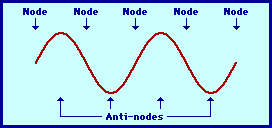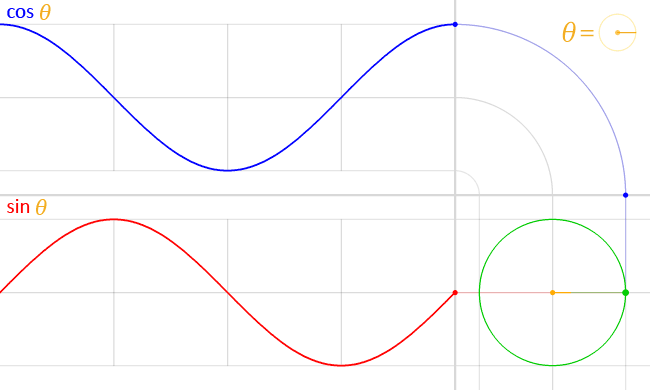Axial, Tangential, and Oblique Room Modes
Nodes and Antinodes |
Axial Room modes involve two parallel walls.
Tangential modes involve four surfaces (two sets of parallel walls) and have around half the energy of the Axial modes.
Oblique modes have about one quarter of the energy of Axial modes and involve all six surfaces--parallel walls, floor, and ceiling!
What are Nodes and Antinodes?
One characteristic of every standing wave pattern is that there are points along the medium that appear to be standing still. These points, sometimes described as points of no displacement, are referred to as nodes. There are other points along the medium that undergo vibrations between a large positive and large negative displacement. These are the points that undergo the maximum displacement during each vibrational cycle of the standing wave. In a sense, these points are the opposite of nodes, and so they are called antinodes. A standing wave pattern always consists of an alternating pattern of nodes and antinodes. The animation shown below depicts a rope vibrating with a standing wave pattern. The nodes and antinodes are labeled on the diagram. When a standing wave pattern is established in a medium, the nodes and the antinodes are always located at the same position along the medium; they are standing still. It is this characteristic that has earned the pattern the name standing wave.
Standing Wave Diagrams
The positioning of the nodes and antinodes in a standing wave pattern can be explained by focusing on the interference of the two waves. The nodes are produced at locations where destructive interference occurs. For instance, nodes form at locations where a crest of one wave meets a trough of a second wave; or a half-crest of one wave meets a half-trough of a second wave; or a quarter-crest of one wave meets a quarter-trough of a second wave; etc. Antinodes, on the other hand, are produced at locations where constructive interference occurs. For instance, if a crest of one wave meets a crest of a second wave, a point of large positive displacement results. Similarly, if a trough of one wave meets a trough of a second wave, a point of large negative displacement results. Antinodes are always vibrating back and forth between these points of large positive and large negative displacement; this is because during a complete cycle of vibration, a crest will meet a crest; and then one-half cycle later, a trough will meet a trough. Because antinodes are vibrating back and forth between a large positive and large negative displacement, a diagram of a standing wave is sometimes depicted by drawing the shape of the medium at an instant in time and at an instant one-half vibrational cycle later. This is done in the diagram below.

Nodes and antinodes should not be confused with crests and troughs. When the motion of a traveling wave is discussed, it is customary to refer to a point of large maximum displacement as a crest and a point of large negative displacement as a trough. These represent points of the disturbance that travel from one location to another through the medium. An antinode on the other hand is a point on the medium that is staying in the same location. Furthermore, an antinode vibrates back and forth between a large upward and a large downward displacement. And finally, nodes and antinodes are not actually part of a wave. Recall that a standing wave is not actually a wave but rather a pattern that results from the interference of two or more waves. Since a standing wave is not technically a wave, an antinode is not technically a point on a wave. The nodes and antinodes are merely unique points on the medium that make up the wave pattern. | |
